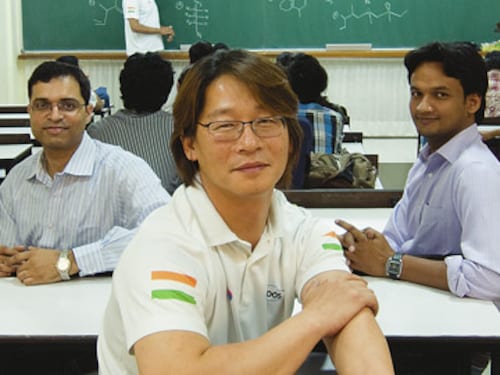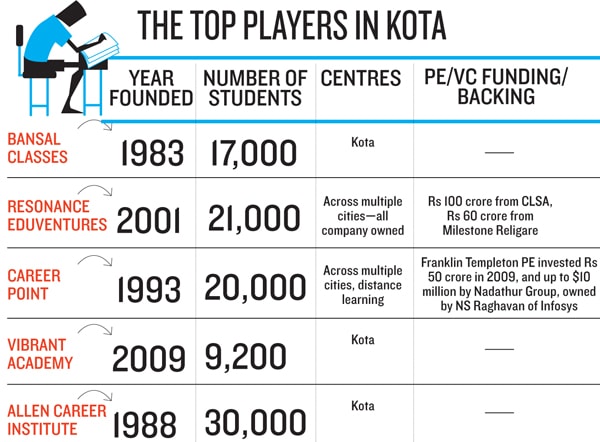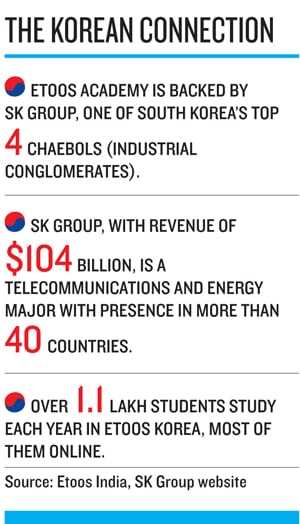The New Coaching Class in Kota
South Korea's Etoos is taking on the top players in Kota's entrance test business. But will its new approach work?


Kota, in Rajasthan, is one of those rare places named after a loser. When Jait Singh of Bundi slew the Bhil chieftain Kotya and captured Akelgarh in 1264, he was so impressed by Kotya’s bravery that he named his newly conquered principality Kotah after him. Ironical, as today thousands throng to this small town, some 240 km south of Jaipur, to win at a more refined version of combat—the entrance examination to top engineering colleges in India.
Situated on the banks of the Chambal River (yes, the same one that passes through ravines once lorded over by dacoits like Paan Singh Tomar and Phoolan Devi), Kota was known more for its saris and a fine-grained variety of limestone. But that changed when an engineer at JK Synthetics, VK Bansal, took up teaching after being diagnosed with muscular dystrophy, a hereditary muscle disease for which there is no cure. He set up Bansal Classes to coach students for entrance tests. By the late 1990s, when Bansal’s students began to regularly figure in the top 100 of the IIT entrance test ranks, Kota became the place to go for those seeking a ticket to the top colleges and a plum job.
When other successful coaching institutes mushroomed (set up mostly by those who branched off from Bansal Classes), Kota changed from a sleepy town to one in which thousands of sleepless students prepared day and night for the tests. The fact that these students spend lakhs of rupees each on tuition and lodging allowed both the coaching centres and the residents of Kota to prosper. And when success comes, so does more competition.
Enter the Koreans
Etoos Academy, backed by the $104-billion SK Group (among South Korea’s top four conglomerates) and one of South Korea’s leading coaching institutes, has set up shop in Kota. Entrance tests are as critical in South Korea as they are in India, if not more. There, more than 80 percent of high-school students move on to higher-level education. So, doing well in the college entrance exams—also known as the College Scholastic Ability Test—is a prerequisite to getting into a prestigious college. Not that different from India, where every year more than 4,50,000 students take the IIT (Indian Institute of Technology) entrance exam and only 3 percent of them are successful.  Infographic: Sameer Pawar
Infographic: Sameer Pawar
The Indian market’s potential is 10 times that of South Korea’s, says Choi Yung Joo, the Korean director, sitting in a small office in the Etoos building in Kota. “There are simply many more students here than there, and the idea of private coaching is very popular,” he says. Unofficial figures peg the Indian coaching market at Rs 15,000 crore. This prompted Etoos, with no experience of operating anywhere outside Korea, to open its first overseas office in Kota two years ago.
The first director of Etoos India, Kang Sung Jin, spent six months in Kota before starting operations. He soon realised that the real rockstars in Kota were the teachers. They were the magnets that attracted students to various institutes. So, he decided to hire the best ‘star’ faculty available.
Like Navneet Jethwani, one of the most sought-after teachers in town. In 2011, when working at Bansal Classes, he got a call from someone who spoke English with an accent. The voice at the other end told Jethwani about a new coaching centre called Etoos. “We are trying out a new approach,” the person continued. NJ sir, as he is known to students, was sceptical, but agreed to meet. Today, he is a faculty at Etoos, and earns more than he ever did.
To really appreciate the celebrity-like status of the star teachers in Kota, all one has to do is look at the billboards. In any other town, they’d be adorned with smiling pictures of film stars or sportspersons endorsing various products. But not so in Kota. Here, they are all about teachers—NKC sir, SK sir, NJ sir, and so on.
Jin ‘poached’ 21 faculty members from Bansal, Vibrant Academy (another top player) and other leading institutes. Of the 21, nine were ‘stars’. According to reliable sources, who wished to remain anonymous, these stars got a salary of about Rs 40 lakh a year. Etoos paid them around Rs 50 lakh-Rs 60 lakh, says a faculty at Vibrant Classes. The exodus of these star teachers dealt a severe blow to the top coaching centres, especially Bansal. It was just recovering from a similar setback in 2009, when seven star teachers broke away to form Vibrant.
A New Method
As for the promised “new approach”, it was not just a sales pitch to a job candidate. At Etoos, the faculty are encouraged to be more than science and maths experts, and spend time with the students, including watching an occasional movie together. This, in a town where sleeping regular hours is considered a luxury. “No one has tried this before. They seem to be making it work, and if they can do that over a larger group of students—that would be a gamechanger,” says a maths faculty member of Allen Career Institute, a rival coaching firm.
But not everyone is gung ho about this new approach. Of the 21 faculty members hired initially, Etoos found that 10 were not enthusiastic about being informal or allowing more student participation. They were asked to leave. “Letting them go was a clear decision. You can’t be here just for more money, without wanting to change,” says Joo, Etoos India’s current director.
In fact, Etoos is so serious about its alternative approach that it trained its faculty for a year on counselling students. And it is making a difference. Take the case of Vinay Singh from Bihar. Something as basic as a flickering bulb in his hostel room led to him solving fewer exercises and falling behind in class. When Jin heard about this, he got a faculty member to reassure Singh and also helped him move to another hostel. The epsiode moved Singh in more ways than one. It changed the way he viewed teaching: “Teachers don’t appear forbidding anymore.”
Kim Dong Woun, the general manager of the coaching centre, says this empathy with students (and the star faculty) was cited by 50 percent of students as a major reason for choosing Etoos. About 20 percent cited the freedom in choosing what they want to study.
Unlike other institutes where taking the complete full-year course is mandatory, Etoos allows students to choose topics. “I was good at certain topics already and yet I had to go through the same topics again. At Etoos, I can pick and choose,” says Arnab Banerjee, who was earlier a student at Bansal. This helped him save on costs and time.
Banerjee now takes monthly classes on specific topics and, as a result, cut his expenses by half—a huge relief for his father, who works in a textile shop in Kolkata. Like most other lower- to middle-class parents, he had borrowed money to fund his son’s studies.
A typical one-year course at Etoos, and other institutes in Kota, costs at least Rs 80,000. Add to that the Rs 5,000 charged by hostels per month, and the figure goes up to Rs 1,40,000 a year. Etoos charges Rs 2,500-Rs 4,000 for courses on specific topics.
Last year, Etoos had 2,000 students, with some trickling in till October. This year, they expect to have 4,000 by September. But it’s still small change compared to the 17,000 students that Bansal Classes enrols every year. Etoos has, however, got its rivals thinking. “They will be stronger than last year in terms of student strength, having experienced how this market works and having star faculty onboard,” says a faculty at Vibrant, who didn’t want to be named.
The Initial Missteps
But initially things were rough. When Jin and Woun first came to Kota in February 2010, they thought a model in which students pay a fee every month would be a big success. They were so sure of the model’s success that when they launched last year, they did not have a one-year course at all.
But it failed. Students were apprehensive and thought that Etoos could be a fly-by-night operator. And there were other issues too—students felt if they joined and, after a month or two, didn’t like what Etoos offered, they had nowhere to go because seats at other coaching institutes would have been already filled.

“It started to seem like this coaching [centre] is not confident of itself, and that I’ll be left in the lurch as all other coaching [centres] would have completed their admissions,” says Vikram Chauhan, a class 11 student in Kota who is with Career Point now. What Jin thought would draw students in was actually turning them away.
“We were at our wits end,” says Woun. The monthly strategy had worked so well in South Korea and they’d expected it to change the market here. Finally, Jin asked a faculty what was going wrong. He also talked to some parents who said they didn’t like what they saw.
“We realised that the one-year course, where you teach everything, was very important to make them feel things are normal,” says Woun. This was last April. They then introduced the traditional one-year course that covered all topics in the IIT-JEE (IIT-Joint Entrance Examination) syllabus. After which students started trickling in.
By May, many more poured in. Woun says that was a pleasant surprise: “We had thought we are done for the year. And then noticed many more who wanted admission—most of them to the one-year programme.”
Bansal Classes, Vibrant and Career Point grew from nothing to million-dollar businesses. Career Point, started in 1993, had revenue of about Rs 80 crore in 2011. VK Bansal was worth $20 million in 2008, according to a report in The Wall Street Journal. Then there are the numerous smaller coaching centres. To rise above the clutter, Etoos is betting on innovation.
Etoos has online tutorials of about 30 to 45 minutes each that can be accessed by subscribers—mostly students who want a more detailed lecture on a topic. From no online revenues last year, Joo expects it to contribute 30 percent this year. “I see students request a particular lecture online, and that’s quite often now,” he says. In the next two years, each topic would be covered in the form of online lectures. That would allow them to reach students much beyond Kota—in all the major cities where broadband is now an affordable reality.
But won’t online classes be one-way, with little participation of students? Joo disagrees. He opens a terminal to show software that allows students to ask questions at a particular point in the lecture. This in-house software is what Joo is betting on. “It took 10 years in Korea to move largely online in the same business. I think India will be there in five.”
So, why Kota? And not a bigger, better-connected city like Delhi? “We wanted to concentrate on one field first—IIT. Delhi would make sense if you are into medical, class 12 coaching and so on,” says Joo. It is not off the radar though. Joo plans to open a centre there by end-2013 to train for both IIT and medical entrance exams. By 2014, Woun says Etoos will open centres in Hyderabad, Mumbai and Chennai.
Interestingly, the monthly study plan is more popular now. “The one year programme showed we have what it takes—now they can trust us,” says Joo, who took over operations early this year. This year 50 percent of their students have opted for the monthly route.
Many options and a different approach, but Etoos will really make an impact in India only if its students do well in the tests. It has made a promising debut though. In this year’s IIT-JEE exams, 182 of its students have been selected, with two of them in the top 100.
First Published: Jun 07, 2012, 06:48
Subscribe Now